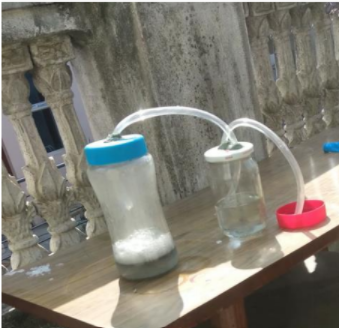activities/ls-ht1/projectsushobhan/
Mini Hydrogen Generator

Sushobhan Bhattarai
sb02238217@student.ku.edu.np
SECTION I – INTRODUCTION
Strong bases attack aluminum. Sodium hydroxide reacts with aluminum and water to release hydrogen gas. The aluminum takes the oxygen atom from sodium hydroxide, which in turn takes the oxygen atom from the water, and releases the two hydrogen atoms, the reaction thus produces hydrogen gas and sodium aluminate. In this reaction, sodium hydroxide acts as an agent to make the solution alkaline, which aluminum can dissolve in. This reaction can be useful in etching, removing anodizing, or converting a polished surface to a satin-like finish, but without further passivation such as anodizing the surface may become degraded, either under normal use or in severe atmospheric conditions.
In the Bayer process, sodium hydroxide is used in the refining of alumina containing ores (bauxite) to produce alumina (aluminum oxide) which is the raw material used to produce aluminum metal via the electrolytic Hall-Héroult process. Since the alumina is amphoteric, it dissolves in the sodium hydroxide, leaving impurities less soluble at high pH such as iron oxides behind in the form of a highly alkaline red mud.
Reaction of aluminum with bases
Aluminum dissolves in sodium hydroxide with the evolution of hydrogen gas, H2, and the formation of Sodium aluminate
2Al + 2NaOH + 2H2O → 2NaAlO2 + 3H2
SECTION II– METHODOLOGIES
Planning
The purpose of the experiment was to produce and test the hydrogen gas. So, I started with the chemical arithmetic of the reaction involved. To establish quantitative relation balanced chemical reaction is taken and on the basis of the nature of the reactants involved and products produced we used mass-volume relationship for the chemical calculation.
By applying mass-volume relationship, we can predict the mass of NaOH required to produce H2 gas.
26 g of Al reacts with 80g of NaOH
1 g of Al reacts with 80/26 g of NaOH
=3.07g of NaOH.
As we mix 1 g of Al and 3.07g we get NaAlO2 and H2 in ratio 2:3.
Similarly, mass of the product can be predicated as
80g of NaOH produces 67.2 litre of H2 gas at STP.
3.07 g of NaOH produces (67.2/80) * 3.07 litre of H2 gas at STP.
= 2.57 litre of H2 gas at STP.
Demonstration
Firstly, I collected the material required for the experiment. It includes Sodium Hydroxide, Aluminum foils, Containers and Delivery Pipe. Firstly, I took the containers, drilled the holes on its and connect delivery pipe and outlet pipe with it. I added 3 teaspoons of sodium hydroxide and make the solution of it in the container added 4-5 aluminum balls I made solution of sodium hydroxide and add aluminum foils in it and close the container. Reaction process starts and hydrogen gas is collected at other container.

Testing
For determining the hydrogen gas, the hydrogen gas was dissolved in soap solution and the flame was brought near to its contact. The pop sound was generated. That determined the hydrogen gas.
Safety Precautions
Like other corrosive acids and alkalis, drops of sodium hydroxide solutions can decompose proteins and lipids in skin, eyes or other living tissues via amide hydrolysis and ester hydrolysis, which consequently causes chemical burns and may induce permanent blindness if it contacts eyes. Moreover, the dissolution of sodium hydroxide is highly exothermic, and the resulting heat may cause heat burns or ignite flammables. It also produces heat when reacted with acids. Solid alkali may also express its corrosive nature if there is water so protective equipment such as rubber gloves, safety clothing and eye protection should always be used when handling the material or its solutions.
Conclusion
We can conclude that we can generate hydrogen gas with the simple process at home with the locally available resources. This produced hydrogen has higher purity and also be can scale up for large scale too with some research. Safety precaution is needed to be taken while carrying out the experiment.
https://youtu.be/JzFQIhHwPNQ
